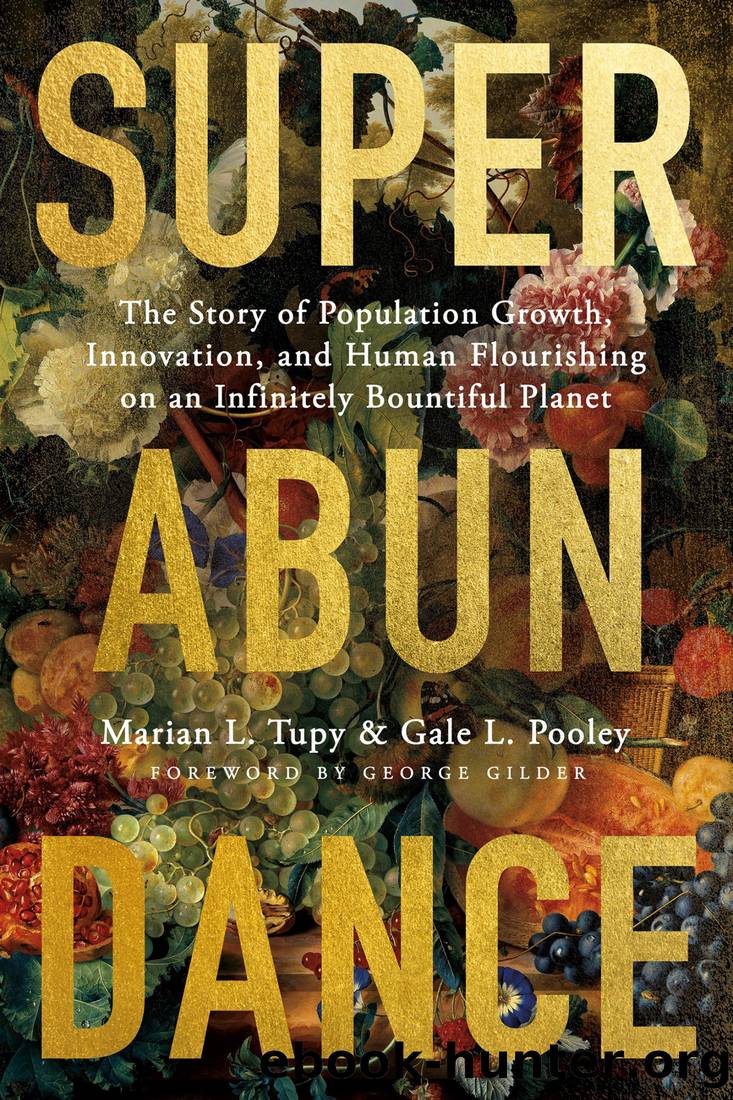Superabundance by Marian L. Tupy & Gale L. Pooley

Author:Marian L. Tupy & Gale L. Pooley [Tupy, Marian L. & Pooley, Gale L.]
Language: eng
Format: epub
Publisher: Cato Institute
â Box 8.1. Bringing humanity out of darkness (1800â2020)
The University of Illinois at Chicago economist and historian Deirdre McCloskey calls the period beginning in 1800 the Great Enrichment.a She notes that inflation-adjusted per capita incomes have risen by 3,000 percent since then. In some ways thatâs a conservative estimate. U.S. blue-collar workers, for example, saw personal resource abundance of 26 basic commodities increase by 5,762 percent between 1850 and 2018.
Measured in time prices (i.e., the time it takes to earn enough money to buy something), many commodities became 99 percent cheaper. Remember that a 99 percent decrease in time price means that the time it took to earn enough money to buy 1 item at the start of the analysis gets the buyer 100 (i.e., 9,900 percent more) items at the end of the analysis.
Between 1850 and 2018, for example, the U.S. blue-collar workerâs personal resource abundance (pRA) of rye, tea, and rice increased 9,840 percent, 10,552 percent, and 11,049 percent, respectively. The pRA of nickel increased by 18,046 percent, and the pRA of sugar increased by 22,583 percent.
The pRA of light has increased even faster. The Nobel Prizeâwinning economist William Nordhaus estimated that buying one hour of light in 1800 required about 5.37 hours of labor.b With advanced LED technology, one hour of light today costs less than 0.16 seconds of labor. That represents a 12,082,400 percent increase in the personal abundance of light.
What about the relationship between population growth and the abundance of light? Remember that we calculate the size of the population resource pie by multiplying personal resource abundance (how much of a resource one hour of labor will buy for one person) by the population size. Comparing the size of the population resource pie at different points in time reveals changes in the population resource abundance (PRA).
Between 1800 and 2020, the pRA of light increased from 1 to 120,825. Over this same period, the worldâs population increased from 1 billion to 7.8 billion, or 680 percent. The population resource abundance of light in 2020 can thus be calculated as 120,825 Ã 7.8, which amounts to 942,435. Put differently, the PRA of light has increased by 94,243,400 percent since 1800. The PRA of light has been increasing at a compounded annual growth rate of about 6.5 percent, thus doubling every 10.8 years.
Finally, elasticity measures one variableâs sensitivity to a change in another variable. Between 1800 and 2020, the PRA of light increased by 94,243,400 percent. Over the same period, the worldâs population increased by 680 percent. Dividing 94,243,400 by 680 equals 138,593. So, every 1 percent increase in the worldâs population corresponds to a 138,593 percent increase in the PRA of light. We have experienced an exponential efflorescence of illumination.
The next time you turn on a light switch, please take a moment to appreciate the freedom and creativity of people who toiled to bring humanity out of the darkness. Compared with the illumination of our world today, all of our ancestors really did live in the âdark ages.
Download
This site does not store any files on its server. We only index and link to content provided by other sites. Please contact the content providers to delete copyright contents if any and email us, we'll remove relevant links or contents immediately.
Navigation and Map Reading by K Andrew(4891)
Spare by Prince Harry The Duke of Sussex(4791)
Tuesdays with Morrie by Mitch Albom(4407)
Cracking the GRE Premium Edition with 6 Practice Tests, 2015 (Graduate School Test Preparation) by Princeton Review(4049)
Machine Learning at Scale with H2O by Gregory Keys | David Whiting(3640)
What It Really Takes to Get Into Ivy League and Other Highly Selective Colleges by Hughes Chuck(3554)
Never by Ken Follett(3533)
Goodbye Paradise(3452)
Harry Potter and the Prisoner of Azkaban (Book 3) by J. K. Rowling(3113)
Pledged by Alexandra Robbins(3049)
Kick Ass in College: Highest Rated "How to Study in College" Book | 77 Ninja Study Skills Tips and Career Strategies | Motivational for College Students: A Guerrilla Guide to College Success by Fox Gunnar(2998)
Fairy Tale by Stephen King(2952)
A Dictionary of Sociology by Unknown(2858)
Sapiens and Homo Deus by Yuval Noah Harari(2845)
Reminders of Him: A Novel by Colleen Hoover(2769)
The Social Psychology of Inequality by Unknown(2768)
Graduate Admissions Essays, Fourth Edition: Write Your Way into the Graduate School of Your Choice (Graduate Admissions Essays: Write Your Way Into the) by Asher Donald(2737)
Get into Any College by Tanabe Gen Tanabe Kelly(2632)
Zero to Make by David Lang(2629)
